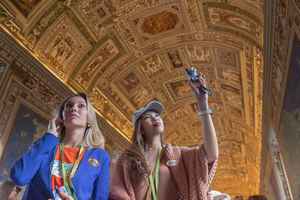Enjoy Rome City Guide: Rome Historical centre
A wander through the centro storico
Note: the following text is originally written in English, in other languages is an automatic translation
Once you have visited the area of the Forum, the Colosseum, and the Vatican, the other really “big stuff” can be covered with a stroll through the cobbled side streets of the historic centre. Enjoy Rome’s 3-hour “Ancient and Old Rome” walking tour covers the Piazza Navona, Pantheon and the Trevi Fountain, as well as the Piazza Venezia, Via dei Fori Imperiali, Roman Forum, and the Colosseum.
There’s something to see at every turn, here are some of the highlights:
Piazza Navona. One of the great triumphs of Baroque urban planning, the piazza’s name derives from its original function as the Stadium of Domitian. Built in the late 1st century to stage athletics competitions -the agones- its name was gradually corrupted by the Roman dialect during the Middle Ages. The “Piazza in Agone” became the “Piazza N’Agone”, and finally the “Piazza Navona”. The Palazzo Pamphilj at the southwestern corner (now the Brazilian Embassy) was made much grander when Giovanni Battista Pamphilj was elected Pope Innocent X, and he set about creating a suitable setting for his family palace, which clearly echoes the form of the Roman stadium which lies beneath. Francesco Borromini was brought in to build the family church, dedicated to St. Agnes, a Roman girl martyred for refusing to marry a pagan nobleman either in or near the stadium. The church’s name Sant’Agnese in Agone refers to the athletic competitions, rather than to any agony she may have felt. The tiny skull of the young St. Agnes is visible, housed in a reliquary in the chapel to the right of the high altar.
In the centre of the piazza, the fabulous Fountain of the Four Rivers by Borromini’s arch-rival Bernini is an extraordinary feat of engineering. Travertine limestone is carved into personifications of the longest known rivers, their poses echoing the ancient Roman river gods, on each of the four known continents. The rocks on which they recline are decorated with relevant flora and fauna. The whole supports a fake Egyptian Roman obelisk, complete with gobbledygook hieroglyphs upon an empty space.
Pantheon (Santa Maria ad Martyres), Piazza della Rotonda (8.30am-7.30pm, Mon-Sat, 9am -6pm, Sun; 9am-1pm public holidays, free). The best preserved building of any ancient civilization, the Pantheon was built in 125 A.D. by Hadrian as a temple dedicated to all of the gods. Its vast concrete, and perfectly hemispherical, dome is a miracle of Roman engineering. Arguably the most influential building ever constructed (whenever you see a structure with a dome it is directly or indirectly modeled on the Pantheon), it was saved from ruin by its consecration as a church in 608 A.D. As well as the tombs of the first kings of Italy, Raphael is also buried here.
Trevi Fountain, Piazza di Trevi (Metro: Barberini). The Trevi is fed by the Acqua Vergine, which has been bringing water from the eighth mile of the via Collatina (to the east of Rome) since 19 B.C. It was the only aqueduct to continue functioning right throughout the Middle Ages because it’s entirely underground and so didn’t get smashed up by marauding invaders. Plans had been underway to build a fountain here from the 15th century, but eventually it was Nicolò Salvi’s design which was built in the 18th century. A spectacular Rococo extravaganza centered around Neptune, and his sons the Tritons who guide the horses representing the rough and calm seas, the fountain takes up the entire façade of the Palazzo Poli. DO throw a coin in the fountain to ensure a return to Rome (the money goes to the Red Cross), DON’T make like Anita Ekberg and climb in, the police don’t like it.
Spanish Steps, Piazza di Spagna (Metro: Spagna). The Piazza takes its name from the Spanish Embassy to the Vatican (the one with the big Spanish flag outside), although the church at the top of the steps (the Trinità dei Monti) belonged to the French, and it was a French diplomat who paid for a splendid staircase to be built to replace the undignified (and often muddy) hill which led up to it. Romans know the staircase as the “Scalinata di Trinità dei Monti”, but (inaccurate) British visitors in the 18th century called it the Spanish Steps and the name stuck. In spring pots of azaleas line the steps, further enhancing its theatrical quality.
At the other end of the via del Babuino, is the Piazza del Popolo (Metro: Flaminio). Given its current form by Napoleon’s favorite architect in Rome, Giuseppe Valadier, the piazza has at its centre an obelisk brought back from Egypt by Augustus. Three roads radiate out from the piazza, via del Babuino, via del Corso, and via di Ripetta, their three prongs giving the enclosed area the name Tridente. Between the roads the 17th century twin churches of Santa Maria di Monte Santo, and Santa Maria dei Miracoli are in fact not identical, one has a round dome and one an oval dome to create an illusion of symmetry in the street plan. On the other side of the piazza the church of Santa Maria del Popolo contains, amongst much else, a funerary chapel designed by Raphael, and two paintings by Caravaggio.
